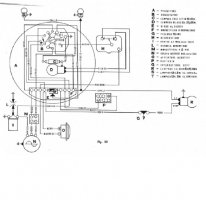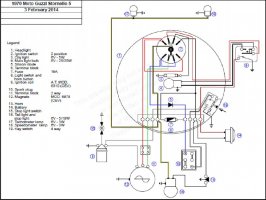Hi guys,
I have got an old good 1974 Stornello that is giving me a lot trouble with the electric circuit.
It has been modified by the previous owner eliminating the battery and changing some connection on main switch.
Now as far as light is working very bad being as low as off when going slow and worst acting brake pedal.
I would like to get back to the original but first i would like to fully understand the logic of the original circuit.
If I look at the original schematic (see picture) I get a bit confused mainly because is missing the internal schematic of the magneto and I can't really imagine how the switch is suppose to change connections in every position.
Has anybody ever look at the schematic and fully understood its logic?
If so, would he like to share his knowledge?
Thanks a lot for your attention
Osvaldo


I have got an old good 1974 Stornello that is giving me a lot trouble with the electric circuit.
It has been modified by the previous owner eliminating the battery and changing some connection on main switch.
Now as far as light is working very bad being as low as off when going slow and worst acting brake pedal.
I would like to get back to the original but first i would like to fully understand the logic of the original circuit.
If I look at the original schematic (see picture) I get a bit confused mainly because is missing the internal schematic of the magneto and I can't really imagine how the switch is suppose to change connections in every position.
Has anybody ever look at the schematic and fully understood its logic?
If so, would he like to share his knowledge?
Thanks a lot for your attention
Osvaldo



